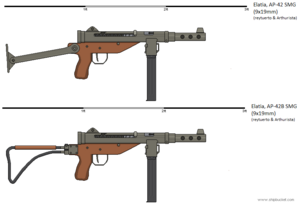AP-42
 AP-42 | |
| Place of origin | |
| Service history | |
| In service | 1942 - 2000 |
| Used by | Elatian Army Charnean Army |
| Production history | |
| Designed | 1942 |
| Produced | 1942 - 1955 |
| No. built | 6 million+ |
| Variants | See Variants |
| Specifications | |
| Weight | 3.4kg empty |
| Length | 760mm |
| Barrel length | 200mm |
| Cartridge | 9x19mm |
| Action | Blowback, open bolt |
| Rate of fire | 500rpm, select fire |
| Effective firing range | 100-200m |
| Feed system | 32-rounds box magazine |
| Sights | fixed iron sight |
The AP-42 ('Automataa Pistolaay 1942') is a model of submachine gun employed by Elatia. It entered service with the Elatian Army in late-1942. Large numbers were purchased from Elatian stockpiles by the Charnean Army at the outbreak of the Ninvite War, where they were used extensively by Charnean vehicle crews for the duration of the conflict.
Conceptualisation
The Elatian Army before the Second Belfro-Elatian War did not pay much attention to submachine guns. They regarded the primary close combat weapons of the infantry squad to be the bayonet and hand grenade. The submachine gun which they did possess, the AP-33, was both heavy and expensive to produce and were primarily issued to platoon NCO's only.
The outbreak of war in 1941 led to a significant increase in the demand for submachine guns. A weapon which was both cheap and easy to manufacture had to be introduced rapidly. In the circumstances, Elatian engineers were inspired primarily by the Arthuristan Sten gun, samples of which were procured from Tikal via organised crime. They took the simple blowback design, changed the orientation of the magazine from horizontal to vertical, reconfigured the sights (the front post was adjustable for windage, the rear consisted of an L-shaped metal sheet with V-notches for 100m and 200m) and added protection for them. The upper receiver was then mated to a lower receiver made of wood to which an underfolding stock was attached.
The gun was conceptualised at the outset with ease of assembly in mind. Its designers minimised the number of parts which required stamping or even welding. Instead, wherever possible, the gun was put together using threads and screws. They were made not only by arms factories, which were under the constant threat of strategic bombing, but also in sheds and workshops by schoolchildren, housewives and clerics. Circa 6 million would be produced before the end of the war.
The design's greatest weakness was its magazine. Of double-stacked, single-feed construction, it was sometimes prone to jamming if not properly handled, especially because the magazine well was also intended to be used as a front grip. The weapon's designers partially counteracted this by reinforcing the feed lip in the production variant, although this potential source of issues was never entirely remedied.
Wartime service
The introduction of an extremely low cost automatic weapon transformed the Elatian infantry. Originally disadvantaged owing to its use of a bolt action rifle against an enemy primarily armed with a semi-automatic weapon, the AP-42 made the close assault tactics favoured by Elatian commanders much more viable.
A late-war Elatian infantry platoon would on average have two rifle squads of six bolt action rifles, two submachine guns and a light machine gun, as well as one to two assault squads equipped with eight submachine guns and a single light machine gun. In other words, more than 50% of the platoon was equipped with an automatic weapon. In the 'Martyrdom Battalions' which increasingly began to appear from 1943 onwards, entire platoons or even companies could be armed with this weapon.
Post-war modification
Subsequent to the war, the Elatian arms industry had an opportunity to review the performance of various small arms and implement refinements. In respect of the AP-42, little could be done about the magazine design (although disposable plastic caps were issued to troops to keep out dust and debris). However, the buttstock was a feature which could be improved. Troops complained of the underfolding stock being awkward to use. As a result, semi-official fixed stock variants made of wood or metal would often be installed as an expediency. Accordingly, beginning in 1947, the AP-42 was given a side-folding stock. New guns, or those so modified, were given the designation of AP-42B.
Suppressed variant
A variant equipped with a suppressor was introduced for use by special forces. Designated the AP-42S (or AP-42BS for the folding-stock variant), it could decelerate normal supersonic ammunition to subsonic velocity. The suppressor also led to a tendency to overheat and as a result the operators were encouraged to fire in semi-automatic mode or short bursts only.
Post-war service
Owing to the sheer ubiquity of the weapon in Elatian service in the post-war era, the weapon persisted in frontline service until it was replaced in the submachine gun role by the AK-54. Subsequently, it continued to be used by pilots, vehicle drivers and rear-area personnel as a self-defence weapon, as well as by reservists and militiamen. Significant stockpiles of the AP-42 existed in the mid-1980s which were sold to Charnea in large quantities as that country mobilized to wage war against Fahran. Although many were destroyed in the course of the war, many examples of AP-42 remained in service for years after the war.
They can still sometimes be found among Elatian paramilitary and security forces as of the 2020's, for example, in the armouries of remote rural police departments, or issued to security guards for banks, railways and post offices. Some suppressed weapons remain in special forces inventories. The Agnannet Police use the AP-42 as a standard issue service weapon, having received the bulk of the remaining Charnean stock of the weapon after they were phased out of Army service in the 2000s.